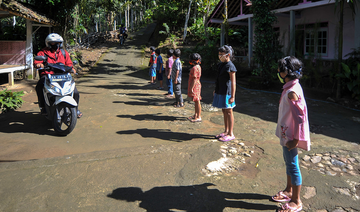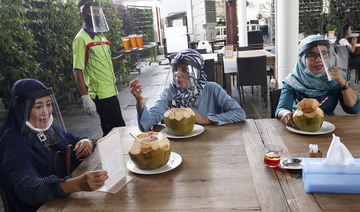JAKARTA: More than 200 refugees and asylum seekers sheltering in a rundown military command headquarters in Kalideres, West Jakarta, remain as isolated as ever.
This is despite the surrounding residential areas returning to life with the gradual lifting of the city’s coronavirus restrictions.
It is a very contrasting world divided only by the fence between those who have set up their temporary homes in small dome tents in the deserted compound and those living in the middle-class residential area.
The lives of the former remain in a state of indefinite uncertainty awaiting permanent resettlement to a third country. The pandemic has been making the situation worse as refugees have had to resort to their own means to isolate themselves and prevent the vulnerable group from contracting the disease.
The community decided to isolate itself after hearing on the news that there were 20 people infected with the disease in the Kalideres area at the beginning of the pandemic, a refugee community spokesperson, Hassan Ramazan, told Arab News.
“The main gate is locked, and we only open the small gate that we take turns to guard to prevent people coming in as we isolate ourselves because of the coronavirus,” Ramazan said when Arab News visited the camp in May.
Refugees have been living in the camp since July 2019. Initially, hundreds of refugees were taken to the temporary shelter, but the Jakarta city administration ordered them to leave the building by August 2019. Some have left while others stayed behind — 245 people from 28 families, 40 children, and single men such as Ramazan. Most of them are Hazara people from Afghanistan, along with a few Iraqis. Four babies have been born during this time at the Kalideres camp.
Electricity and running water are scarce. Even the street lights outside, which provided some lighting to the parking lot, were turned off in the evening, Ramazan said.
“Our lives depend on donations to keep the water and electricity running and assistance comes in occasionally and irregularly. We could have water and food enough for certain days until the next donations come again,” he said.
There were days when donations came in the form of a prepaid electricity token, so the people could have electricity for a certain time. However when the token ran out, and until another was donated, they could be left with no electricity at all for days, Ramazan said.
International agencies had visited the camp informing the inhabitants about social distancing guidelines at the beginning of the pandemic and sprayed disinfectants in the building.
“But that’s it. They told us to wash our hands but they don’t provide us with water. They told us to stay home but where is home for us?” Ramazan said.
Other refugee communities across the city have tried to make the best of the situation by conducting online activities such as knitting, aerobic or English classes for women refugees.
Nimo Adam, a Somali refugee in South Jakarta and an activist at the Sisterhood, a support group for refugee women, said that they were motivated to organize the online classes as they realized the social distancing restrictions had imposed more suffering on refugee women who already faced many uncertainties in their lives.
“We got feedback from our fellow women refugees that at least they got some normalcy back in their daily lives after joining our classes,” Adam said in an online discussion on Friday to commemorate World Refugee Day on June 20.
Refugees in the greater Jakarta area live in clusters in several areas, including Cisarua, a sub-district in neighboring Bogor of West Java province, where large-scale social restrictions have been imposed as part of the country’s anti-virus measures.
“We created a two-minute animated video to raise awareness about the pandemic. The video is narrated in Farsi with English subtitles on how to prevent the spread of COVID-19,” said Hakmat Ziraki, a refugee and co-founder of Skilled Migrant and Refugee Technician (SMART).
The group also collaborated with the Bogor Mayor office to share information about the large-scale social restrictions being imposed, he said.
Ann Maymann, the UNHCR Representative in Indonesia, said in a speech to mark World Refugee Day that refugees are contributing to the frontline of the pandemic, despite living in extremely vulnerable conditions themselves.
“Since the beginning of the pandemic, refugees in many parts of Indonesia have joined hands with the local communities and supporters to sew masks that are then distributed for free to vulnerable Indonesians and refugees that needed to protect themselves from the virus,” Maymann said.
Indonesia is not a signatory to the 1951 Refugee Convention, therefore it is not obliged to take in the refugees, who are now stranded in Indonesia as a transit country since countries that are party to the convention have reduced their refugee intake. According to UNHCR data in Indonesia, 556 departed in 2018 to be resettled in third countries.
Refugees are, however, allowed to stay in the country out of humanitarian concerns and due to the non-refoulement principle (that asylum seekers should not be returned to a country where they could be in danger of persecution), and can have limited access to basic education and health care.
There were 13,657 refugees and asylum seekers registered by the UNHCR in Indonesia by December 2019.
Some 583 refugee children are enrolled in accredited national schools and 3,571 refugees are enrolled in online university courses or community-based education programs. More than half — 56 percent — of the refugees are from Afghanistan.
































